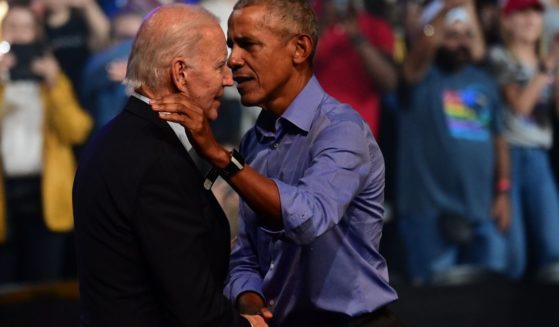New COVID Studies Spell Doom for Democrats' Narrative
We received good news about the coronavirus crisis earlier this month on Twitter, when tweets seemed to indicate we’d solved COVID-related unemployment.
These weren’t statistics that were being tweeted, mind you. I just noticed the number of tweets with the hashtag #TrumpHasCovid after the president was diagnosed with the coronavirus earlier this month. Most of them were vaguely celebratory and written by people apparently unafraid their social media activity would get back to HR.
Jobs are so plentiful, for instance, that people were unabashed about celebrating the fact President Donald Trump was so weak he couldn’t walk up the full set of stairs on Air Force One.
Hey, here’s a #TrumpHasCovid tweet with a dog peeing on a Trump 2020 sign! (“HE IS DA BEST BOY, he knows wut he’s doing,” moral exemplar @em_fl64 informed us about the doggo involved, who was no way induced to do this by an owner who thought the president getting a potentially deadly disease was hee-larious.)
Need someone to make mephitic a “Mexico will pay for the cure” dad joke? There’s a tweet for that.
There was even a #TrumpHasCovid joke about Trump being a bigot and narcissist from a comic strip called (no, seriously) “Covid and Yossarian”:
I don’t think the virus is Trump’s biggest health problem. #COVID19 #TrumpHasCovid #trump pic.twitter.com/dppc5JWmKi
— Covid and Yossarian (@covidyossarian) October 13, 2020
The comic bills itself as a “strip about Covid that is funny, smart and has good art.” I read this description and was reminded of a Margaret Thatcher quote: “Being powerful is like being a lady. If you have to tell people you are, you aren’t.” Don’t know why.
Anyhow, this is fantastic news, since I’m assuming the artist behind “Covid and Yossarian” has confidence he’ll be able to find clients as a graphic artist if this ever gets connected to his resumé. Whoever @em_fl64 is, she is optimistic there are so many jobs to be filled that, when asked why she left her last position, they’ll overlook the fact she was fired because the president got diagnosed with COVID and she tweeted a meme featuring a husky urinating on a Trump campaign sign in response. Chalk one up for the Trump administration.
There was other good news from the president’s COVID-19 scare, that being he made a quick recovery. In fact, despite numerous media sources ominously predicting his demise — and we’ll get to that later — he pulled through pretty quickly and looked energized for a town hall event last week.
Even more good news: It turns out he’s very much not alone. As NPR reported Tuesday, death rates for those seriously affected by the disease look to be going way down.
“Two new peer-reviewed studies are showing a sharp drop in mortality among hospitalized COVID-19 patients,” the public broadcaster reported. “The drop is seen in all groups, including older patients and those with underlying conditions, suggesting that physicians are getting better at helping patients survive their illness.”
In one of the studies, the authors looked at the death rates for a single health system between March and August.
“We find that the death rate has gone down substantially,” said Leora Horwitz of the New York University’s Grossman School of Medicine.
Horwitz, a doctor who studies population health at NYU, said the death rate for COVID-19 “is still higher than many infectious diseases, including the flu,” and that those who recover from serious infections still face lingering complications of which we don’t know the implications.
“It still has the potential to be very harmful in terms of long-term consequences for many people,” she said.
However, the fact is that the study found many more people were alive after treatment.
The study, NPR reports, “finds that mortality has dropped among hospitalized patients by 18 percentage points since the pandemic began. Patients in the study had a 25.6% chance of dying at the start of the pandemic; they now have a 7.6% chance.”
And yes, the cohort of hospitalized patients is changing. “The people who are getting hospitalized now tend to be much younger, tend to have fewer other diseases and tend to be less frail than people who were hospitalized in the early days of the epidemic,” Horwitz said.
The study adjusted for that, though.
“To find out, Horwitz and her colleagues looked at more than 5,000 hospitalizations in the NYU Langone Health system between March and August,” NPR reported. “They adjusted for factors including age and other diseases, such as diabetes, to rule out the possibility that the numbers had dropped only because younger, healthier people were getting diagnosed.
“They found that death rates dropped for all groups, even older patients by 18 percentage points on average.”
Meanwhile, another study from the United Kingdom “shows an unadjusted drop in death rates among hospitalized patients of around 20 percentage points since the worst days of the pandemic,” NPR noted.
Two new peer-reviewed studies show a sharp drop in mortality among hospitalized Covid patients. The drop is seen in all groups, including older patients and those with underlying conditions, suggesting providers are getting better at treating the illness. https://t.co/tAMGC5OsPM
— Scott Gottlieb, MD (@ScottGottliebMD) October 20, 2020
NPR reported that the British study found “drops are clear across ages, underlying conditions and racial groups. Although the paper does not provide adjusted mortality statistics, his rough estimates are comparable to those Horwitz and her team found in New York.”
“Clearly, there’s been something [that’s] gone on that’s improved the risk of individuals who go into these settings with COVID-19,” said Bilal Mateen, an Alan Turing Institute science fellow who conducted the study using data from 21,000 hospitalized COVID-19 patients in the United Kingdom.
A lot of this has to do with standardized treatment and a better understanding of the disease.
“Doctors have gotten better at quickly recognizing when COVID-19 patients are at risk of experiencing blood clots or debilitating ‘cytokine storms,’ where the body’s immune system turns on itself, says Amesh Adalja, an infectious disease, critical care and emergency medicine physician who works at the Johns Hopkins Center for Health Security,” NPR reported.
There are also more standardized treatments for the disease and evidence mask-wearing lowers the dose of the virus people receive, scientists say.
What’s interesting is how much of the rhetoric has centered around the idea that the disease is getting progressively worse in the United States — that somehow, the Trump administration has so mismanaged the virus that things are every bit as bad as they were in the early days.
This played into the establishment media coverage of Trump’s case of COVID-19.
Business Insider’s headline: “One chart shows how Trump’s age, obesity, and other health factors increase his risk of a severe coronavirus infection.”
“At 74, Trump’s risk of dying from the coronavirus is 90 times higher than someone between 18 and 29 years of age. He also has five times greater risk of hospitalization than someone from that age group, according to the Centers for Disease Control and Prevention,” the report gravely noted. “The average fatality rate for a coronavirus patient Trump’s age is around 4.2%, according to Dartmouth researchers, though that study is still awaiting peer review.”
This fatality rate is based on a meta-analysis of papers published before Sept. 17 — but it doesn’t necessarily deal with how cases were handled over time.
And when the articles pointing out the president’s comorbidities did make reference to advancements in medicine, they tended to do so in snarky ways. Here’s The Guardian‘s story: “Donald Trump’s age and weight may cause Covid complications, doctors say.”
“Trump’s ideas about prophylactic hydroxychloroquine treatment and disinfectants were fake news,” said professor Christine Jenkins, head of the respiratory group at the George Institute for Global Health. However, she noted, “Trump is now the beneficiary of very powerful learnings from evidence-based science.”
Get the subtext there? Nudge nudge, wink wink, say no more. It’s great that Jenkins decided this was the time to share this.
And yet, for all Trump’s alleged bumbling and leading the country into a pit of COVID-19 hell, death rates are quietly dropping, and dropping big.
We’re handling a horrifying pandemic by reducing the death rate for hospitalized patients from 1-in-4 to roughly 1-in-14, according to the study.
And yet, listen to the Democrat narrative, which is all about doom and gloom. It’s about reaping what the Trump administration hath sewn, all while refusing to acknowledge any positive developments he’s engendered.
And then there was the schadenfreude of Trump’s own fight with COVID-19.
It wasn’t just Twitter trolls, mind you. The media had its own #TrumpHasCovid party, noting his comorbidities with mock dread and implying he was caught in a web of his own making. Meanwhile, Twitter’s #TrumpHasCovid shindig was much more crude and dispiriting.
The truth is that yes, the disease is still the most dangerous pandemic in over a century. We’re getting a better grasp on how to handle it, though — and after the better part of a year of blaming the president, no one will give him credit for this. What a surprise.
Truth and Accuracy
We are committed to truth and accuracy in all of our journalism. Read our editorial standards.












